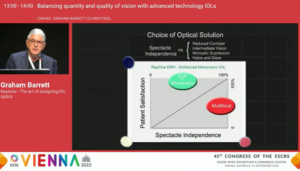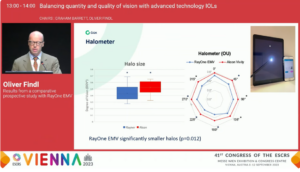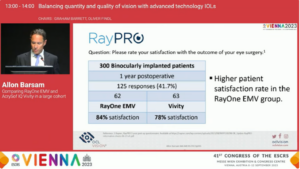Advanced intraocular lenses like Rayner’s RayOne EMV attempt to provide the perfect balance between quantity and quality of vision. How close do they get?
Cataract surgeons know that you can’t have it all when it comes to replacing the eye’s natural crystalline lens. But with today’s advanced optics, patients are getting closer than ever to achieving quality vision at all distances. Truly non-diffractive optics like on Rayner’s RayOne EMV are leading the charge, and top names from the cataract and refractive world broke it all down at ESCRS 2023.
Intraocular lenses (IOLs) have come a long way since the introduction of the first multifocal IOL at the European Intra-Ocular Implant Council (EIIC) meeting in Copenhagen, Denmark, in 1988. Thirty-five years later, at the 41st Congress of the European Society of Cataract and Refractive Surgeons (ESCRS 2023 in Vienna, Austria), a new revolution in optics is underway.
In a Rayner-sponsored symposium at the ESCRS congress, some of the most sought-after minds in cataract and refractive surgery examined the prospects of advanced non-diffractive optics, and lenses using positive spherical aberration (SA) like Rayner’s RayOne EMV IOL. From the optical bench to in vivo clinical studies of the lens, Dr Damien Gatinel, Prof. Oliver Findl and Mr Allon Barsam showed what RayOne EMV, and its novel controlled positive SA design, offers patients and surgeons.
Prof. Graham Barrett, who collaborated with Rayner on the RayOne EMV, introduced the theme of balance with his opening reflection on modern IOL designs. The trade-off with the extreme range of vision with multifocal lenses is a sacrifice in quality.

“How well will the patient tolerate this?” he asked the audience. His answer – and by extension, RayOne EMV’s – is clear in the decision to shun diffractive optics in the lens design to minimise dysphotopsia and photic phenomena.
For Prof. Barrett, this is a large part of the formula for success with IOL optics. “When you look at the options and the balance between quality and range of vision, an extended-depth-of-focus (EDF) or monofocal plus lens such as the RayOne EMV, which utilises positive spherical aberration, gives you that best balance,” he stated.
Claims vs. reality on the optical bench
It was then into the lab with Dr Damien Gatinel of the Rothschild Foundation in Paris. In his talk entitled, Non-diffractive Advanced Optics: Reality or myth?, Dr Gatinel took Prof. Barrett’s musings to the optical bench, where fact-checking manufacturer claims about optical designs yielded intriguing insights.
Dr Gatinel began his presentation by pointing out that not all lenses claiming to be non-diffractive are actually non-diffractive, and he showed this with a side-by-side comparison of a leading EDOF lens (Alcon AcrySof IQ Vivity) and Rayner’s RayOne EMV.
“I wouldn’t be able to say that the [RayOne EMV] is a refractive monofocal or a refractive multifocal because it’s smooth. But with [the other lens], I see concentric zones which evoke a diffractive structure or element or a combined refractive structure […] there’s diffraction optically speaking,” Dr Gatinel explained.
More testing revealed that RayOne EMV really does have a truly non-diffractive optic. Using a NIMO TEMPO (Lambda-X Ophthalmics; Belgium) confirmed that RayOne EMV is exactly what Rayner claims it is.
“When we compared [our findings] to what the manufacturer provided as a description, we were pleased to see that it’s similar to what Rayner disclosed,” Dr Gatinel said. “So, there is transparency – not only with the lens material but in the communications on the optical element provided to doctors.”
“Rayner is a company that so far accurately explains their advanced technologies. The RayOne EMV is a fully non-diffractive IOL, and the depth-of-focus has been shown to be at least 1.5 dioptres throughout a wide range of pupil sizes,” he concluded.
Head-to-head
ESCRS President Prof. Oliver Findl was up next to explain what this all means for patients in the real world, in his talk Results from a Comparative Prospective Study with RayOne EMV.
In the randomised controlled single-centre study, 48 patients were implanted with Rayner’s RayOne EMV and the Alcon AcrySof IQ Vivity. The dominant eye was targeted for emmetropia and the non-dominant for -0.5 D, or mini-monovision.1
The Alcon AcrySof IQ Vivity being compared to RayOne EMV in Prof. Findl’s study was labelled as non-diffractive, but was nonetheless found in Dr Gatinel’s laboratory investigation to contain diffractive elements. And while this would imply that there would be significant differences in range of vision and visual acuity between the two lenses, Prof. Findl’s study showed this was not the case.
“You can see for the Rayner and the Alcon [lenses], there is actually no difference for distance,” Prof. Findl noted, pointing to the 90% of patients with uncorrected distance visual acuity (UDVA) of ≤0.0 logMAR. And when comparing the two lenses’ defocus curves, Prof. Findl ended up giving a slight edge to RayOne EMV for distance and very similar results for intermediate distance. “[The Alcon lens] is a little worse at distance,” he said. The Vivity IOL did, however, have slightly better near-acuity results than the EMV IOL.
Despite the similar performances of these lenses – one with a smooth optic and another with diffractive elements – at distance, the biggest differences came with quality of vision. For contrast sensitivity, it was all RayOne EMV. “The Vivity is actually lower in many of these spatial frequencies,” Prof. Findl noted. And for halos, the results were also clear. “The halo size for the Vivity is larger, and that’s also statistically significant.”

In wrapping up his presentation, Prof. Findl gave his final verdict on RayOne EMV. “From my perspective, the RayOne EMV is especially suited for monovision,” he began. “But you can also use it as your standard monofocal IOL with very good contrast sensitivity. The photic phenomena seem to be comparable to standard monofocal IOLs,” he added.
He was also impressed with the RayOne EMV’s range of vision. “Essentially, you will have uncompromised binocular distance vision. You will have some benefit for intermediate vision – and sometimes even some useful near vision,” concluded Prof. Findl.
More patients, better results?
Mr Allon Barsam, the London-based ophthalmologist who implanted the world’s first RayOne EMV in 2020, picked up the torch from Prof. Findl as he also described clinical data comparing RayOne EMV to the Alcon AcrySof IQ Vivity.
Mr Barsam sought to show how Rayner’s claims and clinical study results, like Prof. Findl’s, would hold up in a much larger cohort – 820 eyes in 517 patients. His findings went beyond Prof. Findl’s takeaways about the differences between RayOne EMV and the Alcon AcrySof IQ Vivity.
“In this big, real-world retrospective study, there was statistically significant better uncorrected distance visual acuity and corrected distance visual acuity [with RayOne EMV],” he said. “There was no significant difference in uncorrected intermediate visual acuity.”
Mr Barsam’s study also reached deeper into the patient side of things, and a digital post-op questionnaire using RayPRO (Rayner) yielded high patient satisfaction scores, to the tune of 84% of respondents for RayOne EMV versus 78% for the Alcon AcrySof IQ Vivity. “We presume this difference in satisfaction to be due to the tolerability of mini-monovision or the improved distance vision you get with RayOne EMV,” he inferred.

When thinking about further research needed, Mr Barsam noted the relevance of a cost-benefit analysis between the RayOne EMV and AcrySof IQ Vivity, with Mr Barsam describing the cost difference as “enormous” given the modest variance in performance between the two lenses.
In the end, Mr Barsam’s voice joined the chorus of praise for RayOne EMV and non-diffractive optics. “With the RayOne EMV, we clearly have a technology that maximises the quality of vision[…] and I think that’s reflected in patient satisfaction,” he summarised.
“What patients really want is good quality of vision – and spectacle independence, or a degree thereof, they see as a bonus, especially if you can get them a bit more [near vision],” added Mr Barsam. And for Profs. Barrett, Findl, Dr Gatinel and Mr Barsam, this is the promise of the RayOne EMV and its fully non-diffractive optic that utilises controlled positive SA – and the research shows the power of what this makes possible for the patient and the surgeon.
Watch the full symposium
Learn more about RayOne EMV at www.rayner.com/EMV
Reference
- Findl O. Performance of two intraocular lenses with extended depth of vision. Available from: https://classic.clinicaltrials.gov/ct2/show/study/NCT05194150. ClinicalTrials.gov Identifier: NCT05194150. Accessed on 15 September 2023.
The information presented in this article is intended solely for general informational purposes only, summarising discussions and findings presented at a clinical symposium. Any comparisons between Rayner and competitor products are based on the information available at the time of the symposium. Product attributes and performance may have evolved since then. The symposium was sponsored by Rayner in which these discussions took place. The speakers at this symposium were compensated by Rayner to provide their honest opinions about the products. Competing interests, if any, were disclosed to symposium attendees and are subject to the symposium’s transparency and conflict-of-interest policies. Nothing contained within this article is intended to offer medical advice for the treatment of any illness or disease, nor is it a substitute for professional medical advice, diagnosis or treatment. Nothing presented in this article is intended to give instruction or guidance on the use of any Rayner products; it is not designed to replace a surgeon’s independent judgement about the appropriateness or risks of a procedure for a given patient. Rayner does not endorse off-label use. Users must refer to the product labelling and instructions for use for Rayner products in all cases.
© 2023 Rayner Group, all rights reserved. Rayner, RayOne and RayPRO are proprietary marks of Rayner. All other trademarks are property of their respective owners. Rayner, 10 Dominion Way, Worthing, West Sussex, BN14 8AQ. Registered in England: 615539. EC 2023-154 10/22